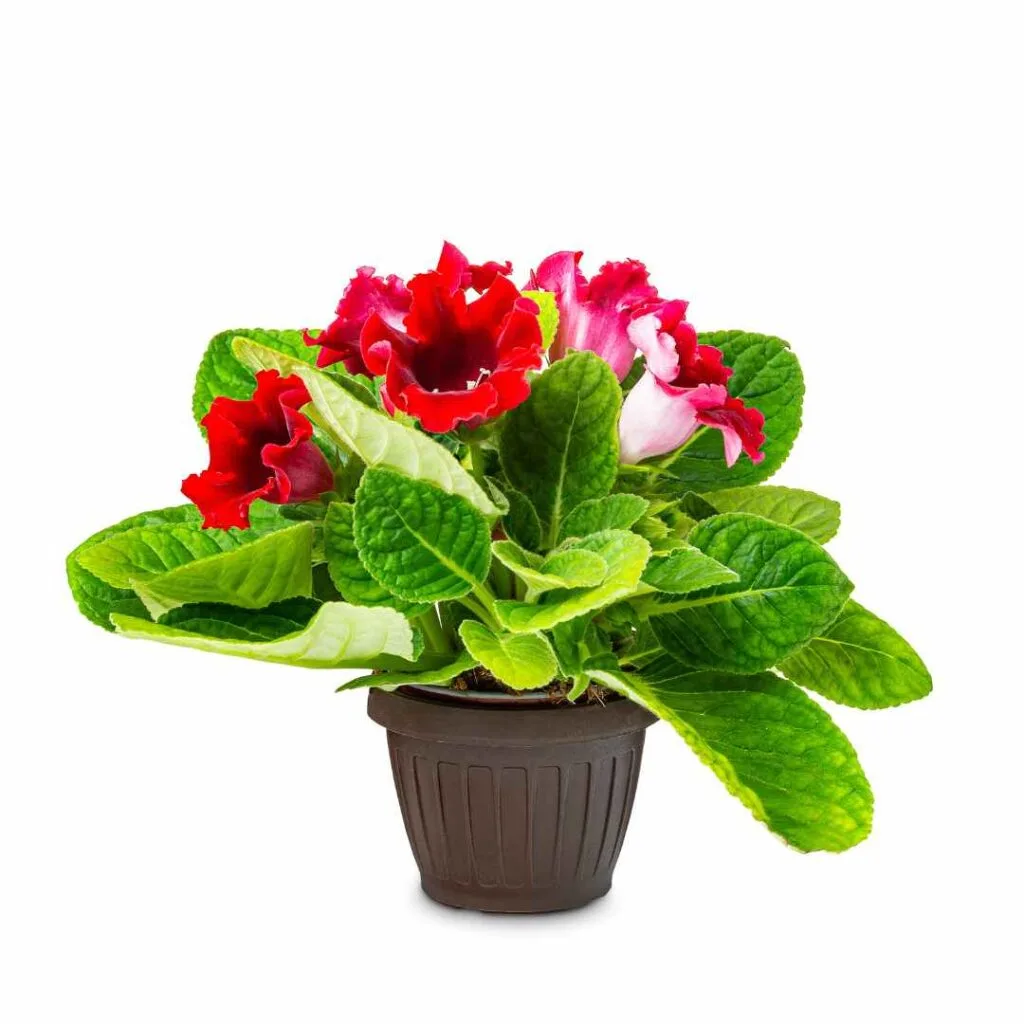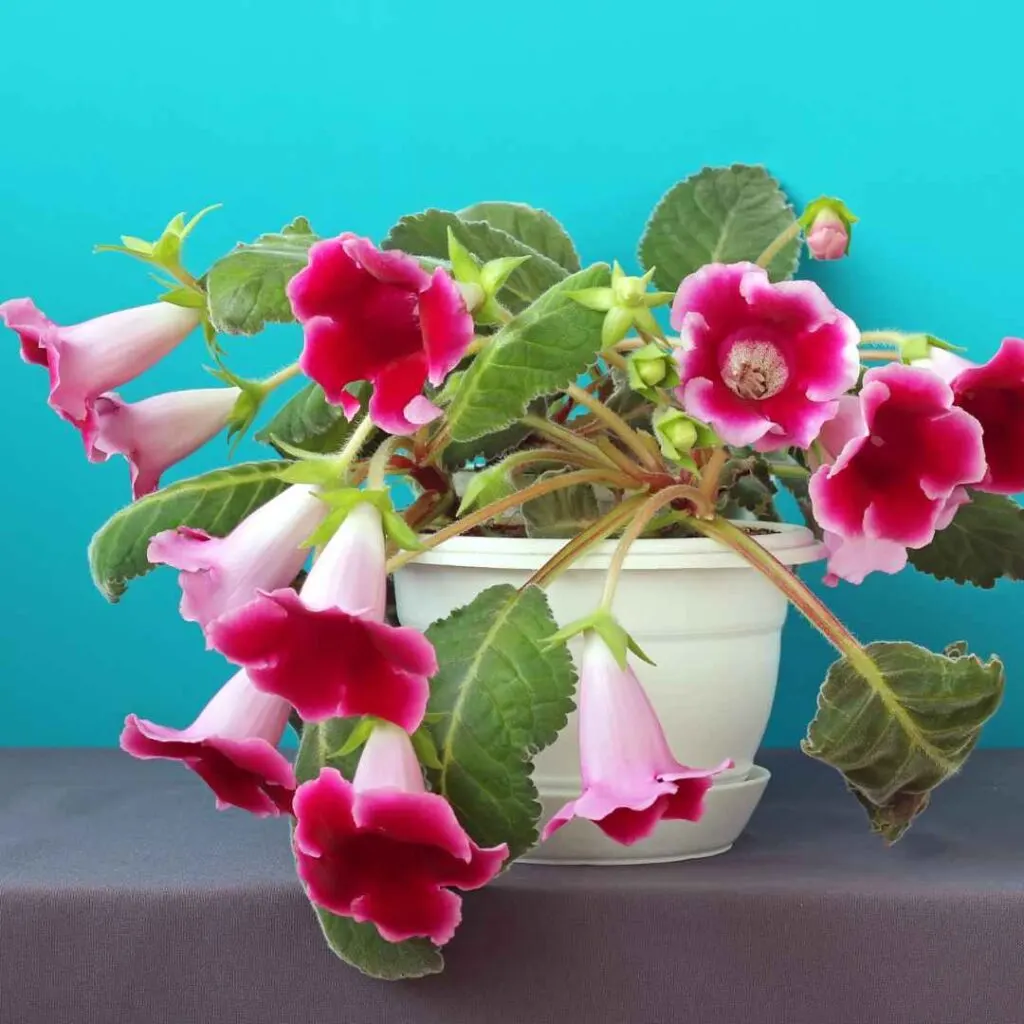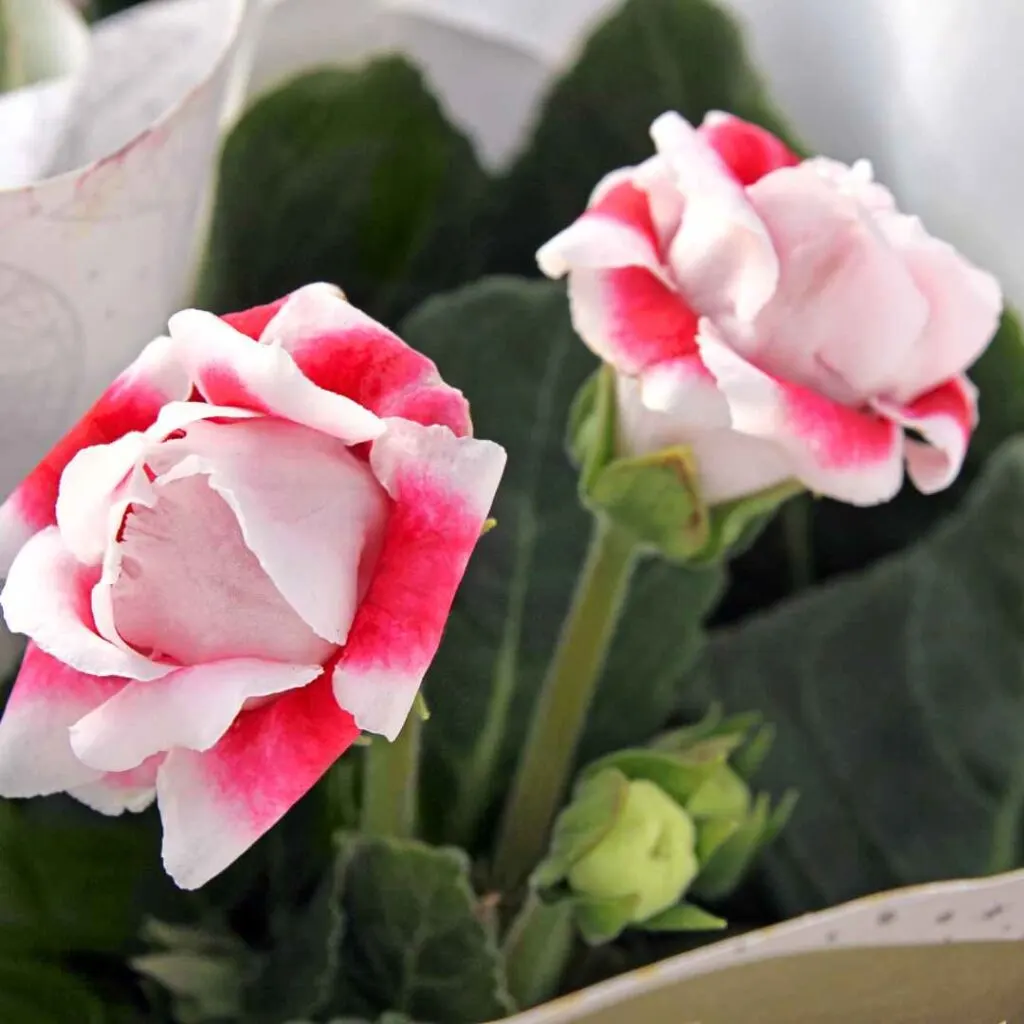Gloxinia is a plant genus that holds many varieties and provide beautiful pops of color both in your home, or depending where you live, in your gardens and flower boxes. Most varieties that you encounter today are hybrids cultivated for visual beauty and interest with various color combinations; as well as adaptations to make them an option for houseplants.
Gloxinia hybrids are very similar to African Violets both in appearance and growth habits because they are part of the Gesneriaceae family which also includes the intriguing Lipstick Plant. These plants all produce vibrant flowers that pop against their lush green leaves creating beautiful centerpieces and additions to flower box arrangements.
The Gloxinia are considered easy to grow, and the care is similar to their sister plant, the African violet. They make great ‘temporary’ plants to enjoy during their flowering stage, because once they are done flowering they never really regain their original vigor. Because of this, most folks will discard the plants once they have finished flowering and select a new color to enjoy.

Can a Gloxinia Bloom a Second Time?
These plants, while able to regrow from their tuber, are best treated as annuals and discarded after their flowering stage has finished. Gloxinia hybrids won’t ever regain their vibrant vigor after the initial bloom, so it really isn’t worth keeping them longterm.
You will find a wide variety of flower shapes and color combinations in the Gloxinia family. This makes for a fun opportunity of exploring and enjoy as many as you can because of the ‘temporary’ nature of this plant. They make perfect gifts for friends and family because they aren’t going to require a long term commitment from the recipient. They can enjoy the growth and discard the plant once it has finished its blooming stage.
Gloxinia Hybrids Care Guide and Profile
| Sun + Light | Bright, indirect light with partial shade is best |
| Watering | Keep the soil lightly moist, be careful that no water touches the leaves |
| Soil | Acidic 5.5-6.5 well draining soil similar to the mix that African Violets need |
| Temp + Humidity | 70-78 degrees F with humidity, they do not like dry heat |
| Bloom Season | Summer is the blooming season, its best to discard after this is done |
| Flower Varieties | White, purple, red, blue, pink, and lavender |
| Full Maturity | 6-12 inches wide and tall making them darling potted options |
Gloxinias do require some specifics in order to thrive during their short prime, but overall they are not challenging to care for. While they can be kept long term, it really isn’t worth the fuss since they will never have the same strength and vitality that they had during their first bloom. They are best cared for through the initial blooming season and then discarded.
Can Gloxinia Hybrids Get Disease and Pest Infestations?
Yes, just like any other plant the Gloxinia hybrids are susceptible to fungus and common plant pests including aphids, mealybugs, white fly’s and scale. Our in depth post will walk you through what to do in the event of an infestation and how to properly sanitize your home to protect your other plants.
Gloxinia hybrids are also very sensitive to lack of airflow and water on their leaves, both of which can quickly lead to rot. It’s important to protect the leaves from all water and set this plant in an area that is airy and open. This can be a tricky balance because the Gloxinia requires humidity in its environment, but too much will lead to excess moisture and rot on the plant.
Although these plants thrive in warm temperatures and humidity, it’s important not to mist the plants or allow water to come in contact with the leaves.

Pruning and Propagating a Gloxinia
The Gloxinia will thrive when dead or dry leaves are gently removed. This encourages growth, reduces the chances of fungus and rot, and allows more airflow for the healthy blooms to thrive. Simply pinch the dead leaves off as you notice them, they should easily release when they are dried out.
Propagating a Gloxinia, while not necessary, can be done if you would like to hold onto a specific plant. Just keep in mind, the hybrids are not curated to bloom in their full vigor again, and will likely produce smaller, less vibrant blooms.
Propagation Through Leaf Cuttings
- Take healthy leaf cuttings during the active growing season and spout them in fresh seed starting soil or airy sand based soil.
- Place the young cuttings in areas where they will receive partial sun and not be exposed to direct heat throughout the day.
- The soil needs to remain lightly moist, and over time the young cuttings should take root.
Propagation Through Tubular Division
- Gently divide tubers if and when you are repotting the plant, during the dormant season.
- The tubers can be placed in smaller individual pots and cared for as normal.
- Tubers will eventually sprout and begin to grow, but they will never be as large or vibrant as the original mother plant during the initial bloom.
- Flowering can happen at different times throughout the year depending where you live and the conditions that they Gloxinia is living in.
Can I Grow Gloxinia from Seeds?
Gloxinia plants can be grown from seeds if you would like the challenge. This will of course take time and require some extra care and an experienced hand.
- Be aware that the seeds are extremely fine, delicate, and super tiny. They will need to be protected and dealt with gently for a successful chance to grow.
- Sprinkle the seeds on top of the potting soil and very gently spray with water.
- Don’t cover the seeds with soil, instead place the pot in a warm, well lit area until germination occurs.
- Once the seedlings have produced at least two pairs of leaves, they can be carefully moved to a larger pot to grow and bloom.

Fertilize During the Gloxinia’s Bloom Season
The Gloxinia will become absolutely stunning and vibrant during their first bloom, and have been curated to put all of their energy and vibrancy into these first flowers. Fertilizing the plant through this stage will not only strengthen the plant, but will also give the blooms more color, vibrancy, and even a slightly longer life span before dying off.
Fertilize during the growing season of summer with a liquid fertilizer or a slow release fertilizer following the directions on the label. Be careful not to get any on the leaves of the plant, as they will likely burn and could become susceptible to rot or fungal growth.
Reduce the fertilizer during the dormant season if you are keeping the plant. This will give the plant its much needed rest for a successful second bloom.
Where Can I Get Gloxinia Hybrids?
These plants have been made widely and easily available through many sources including local plant nurseries and growers. You will likely find them in late spring as the growing season of summer is their time to bloom and shine.
If you are looking for a specific color combination or flower variety, you may need to source a Gloxinia online. There are lot’s of options to choose from including Etsy where we have had success in sourcing various houseplants.
Just make sure that you do your research and use a reputable and reliable shop that you can trust.
Click here to browse Etsy for a variety of Gloxinia plants, seeds, and tubers
If you are looking for more easy, beginner friendly plants check out our video below! These plants are all fantastic options if you are looking to build a collection of long term plants that you can enjoy for years.
Follow Us:
Find us on YouTube, Instagram , Pinterest and TikTok! We love to Plant chat. We also comment, like and occasionally share your content to our daily stories. We’d love to see your plants. Share your joy in your houseplants. Happy Planting!

